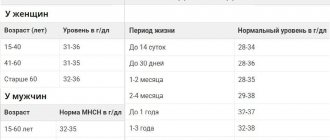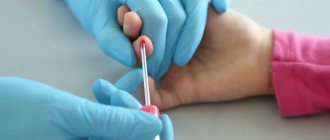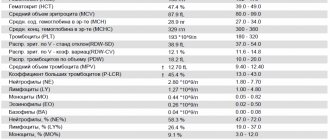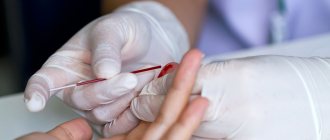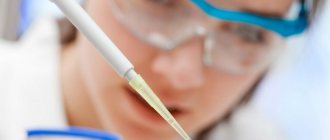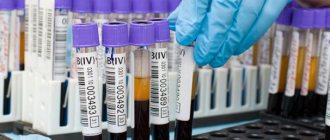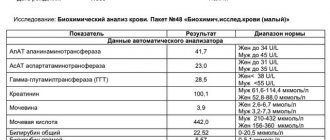- Hemoglobin, abbreviated as HB, HgB is a protein rich in iron that binds to oxygen in the body;
- Oxygen - O2 - is involved in 90% of the processes of obtaining energy for the body, it is transferred from the lungs to cells with the blood;
- Red blood cells (RBC - Red Blood Cells, English) - red blood cells, the main transporter for oxygen;
- Hematocrit is the volume that is occupied by red blood cells in the bloodstream;
- MCHC (Mean Cell Hemoglobin Concentration) is an indicator of the density and filling of an erythrocyte with hemoglobin. Differs from MCH - the amount of HgB in the erythrocyte;
- The study of hemoglobin density is part of a general blood test and is not carried out separately.
MCHC blood test - red blood cells and hemoglobin
The erythrocyte formula of a laboratory blood test consists of 8 different indices, is included in the general blood test (CBC) and is a fairly detailed, informative study. Among other points, the results based on the MCHC index data from the complete erythrocyte formula mean with what density hemoglobin is distributed throughout the erythrocyte, exactly how much HgB can be transported by the erythrocyte along the bloodstream to tissues and cells. In the results of the OAC, this index can be found under the name “average hemoglobin concentration”.
In the case of the density of HgB in a red blood cell, the rule “the more, the better” does not work, since hemoglobin has the task of not only binding and transporting oxygen, but also delivering the processed volume, that is, carbon dioxide to the lungs “for exhalation.” At a high concentration within the boundaries of one red blood cell, hemoglobins lose their structural quality: the thickness of the cell membrane is disrupted, and oxygen transfer becomes difficult.
Any deviation of the indicator from the norm indicates that gas exchange is impaired, and there is some problem in the body related to hematopoiesis. To find out what exactly it is, doctors turn to other tests.
What do high and low MCHC levels mean?
In a situation with a paradoxically high level of this indicator, you should not be nervous; this phenomenon cannot be called widespread. If the CBC results show a mean hemoglobin concentration that is significantly higher than 37 g/dL (or is also measured in %) it is best to first assume a laboratory error. For clinical practice, such high values are very rare; hemoglobin crystallizes at such concentrations. Therefore, in such cases, a repeat blood test is always performed.
What happens at high rates
First of all, this indicates a lack of fluid and a violation of the water-salt balance. An equally common cause may be a lack of vitamins, and almost always these are representatives of group B. With a deficiency of B9 / B12 in the blood, that is, folic acid or the cobalamin group, anemia develops, better known as anemia: folate deficiency, pernicious (megaloblastic).
What does a low score mean?
This is considered a result of less than 30 (units or percent). In this case, one should suspect a deficiency of pyridoxines (derivatives of vitamin B6) or insufficient absorption of iron, its sudden loss. In women, iron deficiency can be caused by hormonal changes and associated with the characteristics of the monthly cycle and menopause. Pathological conditions - hereditary, autoimmune - can also be hidden behind a low HgB density index in the blood.
The indices for both red blood cells in other tests and HgB decrease.
Reference values for hemoglobin density in erythrocytes
If the test results for the erythrocyte index are satisfactory, depending on the state of health and physical activity, preventive courses of taking micronutrients are recommended. Iron supplements and vitamin B6 are more often required; this compound actively helps the proper absorption of this microelement.
Prevention of hematopoietic pathologies is especially important for everyone who has bad habits - for example, drinking alcohol, nicotine. These toxic substances have the ability to gradually but inevitably inhibit hematopoiesis, reducing the volume of red blood cells in the blood. Among other things, alcoholic drinks have a detrimental effect on the functioning of the bone marrow, where red blood cells mature. This disrupts the delivery of oxygen to cells.
Oxygen in the body
The role of this macroelement in the body, simply put, is one: redox reactions. But such modesty is deceptive, since oxygen is the most important life-forming organogen, that is, a chemical element without which not a single type of metabolism can exist.
- Part of proteins, hormones, enzymes, vitamins, nucleic acids and other compounds in the body, including low molecular weight ones;
- Oxidizes carbohydrates, proteins, fats with the release of necessary energy;
- Participates in the reaction of phagocytosis - disposal of waste cells;
- The most important element in the launch of immune functions;
- When there is a lack of oxygen in the blood, free radicals accumulate - molecules that accelerate cell aging and increase the risk of developing diseases, including malignant tumors (cancer).
What does hemoglobin affect?
First of all, this is a priority “delivery service” for oxygen, figuratively the highway with the busiest traffic. Each HgB molecule inside the red blood cell combines with four oxygen molecules from the lungs, then the bloodstream delivers the mixture to those tissues and cells that lack O2 to carry out the oxidative reaction and obtain the necessary energy.
In addition to this global load, hemoglobin also takes in the product of oxygen processing - carbon dioxide. Approximately 15% of the total volume of carbon dioxide (CO2) is transferred from cells back to the lungs, also by hemoglobins.
A lack of HgB creates significant difficulties with oxygen transport, which means an imbalance occurs for all types of metabolism. The pH of cells and the production of nutrients are disrupted, overall functionality decreases, but the vulnerability of cells to pathogens increases.
Lack of oxygen caused by low density and quantity of hemoglobin also leads to disruptions in the Krebs cycle:
- this is a key, priority system that ensures cellular respiration;
- is the final stage of energy production;
- connection between catabolic and anabolic reactions.
In addition to this functionality, which has the highest priority in the body, it is hemoglobin that gives the blood its rich red color.
MCHC blood test explanation
A normal mchc value is considered to be between 310 and 380 g/l. Such values are considered the norm for adults of both sexes. In newborns, children, and adolescents, the normal limits are shifted downward. For children under 1 year of age, the average amount of hemoglobin in a red blood cell is considered to be 290-370 g/l.
After the completion of puberty, the normal concentration of iron-containing proteins stabilizes and remains throughout life within certain limits (in the absence of pathologies that can affect this indicator).
It is important to consider that finding the mchc index in the range of normal values does not always mean the absence of pathologies. There are anemia and other diseases that do not manifest themselves as a change in the mchc level in a blood test.
Vitamins, microelements and hemoglobin
The choice of micronutrients and the need to take complexes should be considered from different perspectives:
- Against the background of pathological conditions
In this case, the addition of any multivitamin preparations, except those aimed at treating diseases of the hematopoietic system, must be discussed with the attending physician. Inflated hemoglobin density indicators require special attention, since additional intake of B vitamins will cause a new increase in the index or no decrease in the blood test results.
At the same time, at low levels, taking B vitamins and iron supplements is completely justified, since it is these compounds that help restore values to normal.
- Prevention and prevention of diseases
The choice of micronutrients in this case also requires preliminary discussion with a specialist who will focus exclusively on the results of blood tests. In addition to the erythrocyte index, you will need indicators for leukocytes and platelets - all this data will be reflected in the CBC.
A general study of blood quality, together with a biochemical analysis and results on the presence and concentration of vitamins, is the most informative picture of the state of health. This combination of blood tests, in addition to diagnosing diseases, is widely used in dietetics and pediatrics, and allows one to determine the actual, personal need for micronutrients.
How often should you take a general blood test?
The frequency of health monitoring is determined by the attending physician, if we are talking about the presence of diseases. In this case, there are no restrictions on taking any blood test; the studies will allow you to quickly respond to changes in your health status and change the course of treatment in a timely manner.
For everyone without abnormalities, it is recommended to repeat the CBC annually to confirm the absence of abnormalities or to detect imbalances at an early stage.
For those who do not take a passive position in matters of caring for their own health, OBC, biochemistry or vitamin tests are taken according to a plan determined by the goals of the micronutrient intake program and lifestyle.
First check-up
An indicator of health status at a current moment in time. Based on these data, not only a personal formula for the concentration and combination of vitamins and micronutrients can be developed, but also a nutritional part, a diet, if weight correction is required.
Second check-up
The life cycle of red blood cells is no more than 4 months, and there is no synchronicity in RBC renewal. To monitor the first results of taking a multivitamin complex according to an individual formula, you will need to donate blood again before the majority of the red blood cells are replaced. But you also shouldn’t rush, especially in the case of combined health support methods. The body’s reaction to changes in diet and/or physical activity 6-7 weeks after the start of the program will be exhaustively informative.
Every next check-up
The frequency of checking your own successes is determined by their severity. If the body responds sensitively to the introduction of micronutrients into the nutrition plan, the trend is very likely to continue. The date of any inspection after the second check-up in this case is set arbitrarily or every 2 months if there are grounds for additional control measures. Risk factors include primarily bad habits and excess weight. Adhering to the schedule of laboratory tests is also recommended for everyone who is faced with infectious viral diseases, injuries, and stress.
Where to get tested for hemoglobin
In this case, we are talking about a comprehensive OBC test - as part of this blood test, not only the hemoglobin density in the red blood cell is examined, but also other characteristics of red blood cells. A general study is carried out in most laboratories of medical clinics; choosing the most comfortable one is a matter of habits, convenience of location, and cost.
It is not always possible to find a time to visit the clinic and start a healthy lifestyle program. Understanding all the nuances of the busy pace of life and work, bioniq specialists will collect material for analysis at your home or in any convenient place.
- Visit of medical staff with specialized education (highest category);
- Sterile equipment and instruments;
- Antibacterial and antiviral protection products;
- 50 blood test parameters;
- Personal composition of the micronutrient complex;
- Personal account and information about research results, recommendations individually, based on laboratory research data;
- Free for bioniq LIFE subscribers.
MCHC in blood test is increased
A high mchc index occurs when the concentration of iron-containing proteins in red blood cells increases. Such conditions are usually observed in various genetic pathologies. The most common:
- Hereditary spherocytosis. This is a disease in which the formation of the erythrocyte cytoskeleton is disrupted. As a result, the surface area of the cell membrane decreases, its plasticity is disrupted, and the concentration of hemoglobin in the cell increases significantly. You can find out about the analysis of hemoglobin levels here. Spherocytosis often occurs in hidden, benign forms and is detected only during screening diagnostics.
- Sickle cell anemia. One of the most common congenital diseases of red blood cells. As a result of disturbances in the process of hemoglobin production, red blood cells acquire a changed shape, and the mchc index increases. In such patients, hemoglobin has a different structure from the norm and carries oxygen less efficiently. If pathological genes are passed on from one of the parents, the disease occurs in a latent or mild form and provides immunity from malaria. When receiving defective genes from the mother and father, sickle cell anemia is severe and can cause serious pathologies and death.
- Hemoglobinosis C. A severe hereditary pathology that develops when both parents receive defective genes that direct the synthesis of erythrocyte proteins. Manifests itself in the form of hemolytic jaundice, chronic anemia, the most common complication is cholelithiasis. Defective hemoglobin is produced by the body in significant quantities because it carries oxygen worse than normal protein. As a result, a sharp increase in mchc index values is observed.
An increase in the mchc index does not always serve as a signal for the development of pathological processes. This figure may increase as the body recovers after severe blood loss. For residents of high mountains, an increase in hemoglobin concentration is a normal option as it serves to compensate for the low oxygen content in the air.
Therefore, professional climbers may experience a significant increase in the mchc index, which, in the absence of other pathological symptoms, should be assessed as normal.
